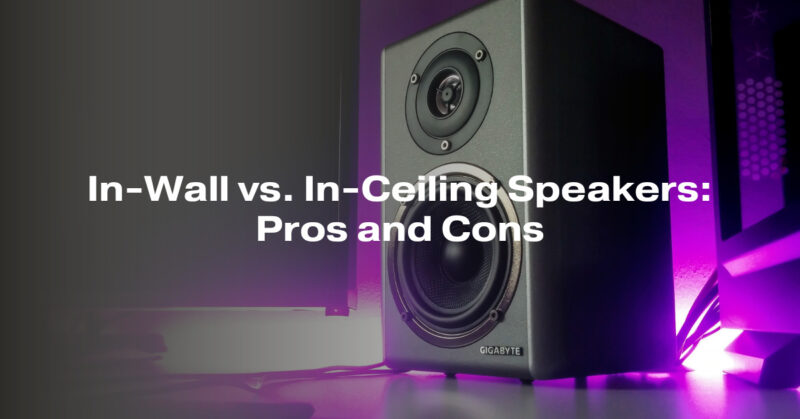In-wall and in-ceiling speakers are two popular options for achieving a clean and unobtrusive audio setup in your home or commercial space. Each type has its own set of advantages and disadvantages, depending on your specific needs and preferences. Here’s a comparison of in-wall vs. in-ceiling speakers:
In-Wall Speakers:
Pros:
- Aesthetic Integration: In-wall speakers are flush-mounted into the walls, offering a discreet and unobtrusive appearance. They can be painted or covered with wall material to blend seamlessly with the room’s decor.
- Stereo and Home Theater: In-wall speakers are suitable for stereo audio systems and home theater setups, where they can serve as front, center, and surround speakers for an immersive experience.
- Space-Saving: In-wall speakers don’t take up floor or shelf space, making them an excellent choice for smaller rooms or areas where floor-standing or bookshelf speakers may be impractical.
- Directional Control: Many in-wall speakers feature adjustable tweeters or pivoting drivers, allowing you to direct the sound toward the listening area for better imaging and sound dispersion.
Cons:
- Installation Complexity: Installing in-wall speakers typically requires cutting holes in the walls, running speaker wires within the walls, and ensuring proper placement. This can be a more involved process than installing traditional speakers.
- Limited Placement Flexibility: Once installed, in-wall speakers are fixed in position. If you decide to change the speaker location, it may require additional construction work.
In-Ceiling Speakers:
Pros:
- Inconspicuous Design: In-ceiling speakers are mounted flush with the ceiling, making them nearly invisible and ideal for maintaining a clean and clutter-free room.
- Multi-Room Audio: In-ceiling speakers are commonly used for multi-room audio systems, allowing you to distribute music throughout your home. They are often used in kitchens, bathrooms, and hallways.
- Ambient Sound: In-ceiling speakers provide ambient sound that can fill a space evenly, making them suitable for background music and distributed audio.
- Easy Installation: Installing in-ceiling speakers is relatively straightforward and requires fewer modifications to your room compared to in-wall speakers.
Cons:
- Sound Directionality: In-ceiling speakers can lack precise sound directionality, which may affect stereo imaging and localization in a home theater setup.
- Limited Sound Quality: While in-ceiling speakers can provide decent sound quality for background music and general use, they may not deliver the same level of audio fidelity as dedicated, free-standing speakers.
- Ceiling Obstructions: Ceiling obstructions like beams, ducts, and lighting fixtures can limit the placement options for in-ceiling speakers.
Which Is Right for You?
The choice between in-wall and in-ceiling speakers depends on your specific audio needs, room layout, and aesthetic preferences. Here are some general guidelines:
- In-wall speakers are ideal for home theater setups, where precise sound directionality and placement are crucial. They are also suitable for stereo listening in rooms where floor space is limited.
- In-ceiling speakers excel in multi-room audio systems, distributed audio setups, and spaces where a discreet appearance is desired. They provide background music and ambient sound evenly throughout a room or multiple rooms.
In some cases, a combination of both in-wall and in-ceiling speakers may be the best solution to meet all your audio needs, allowing you to enjoy high-quality sound without sacrificing aesthetics or practicality.

